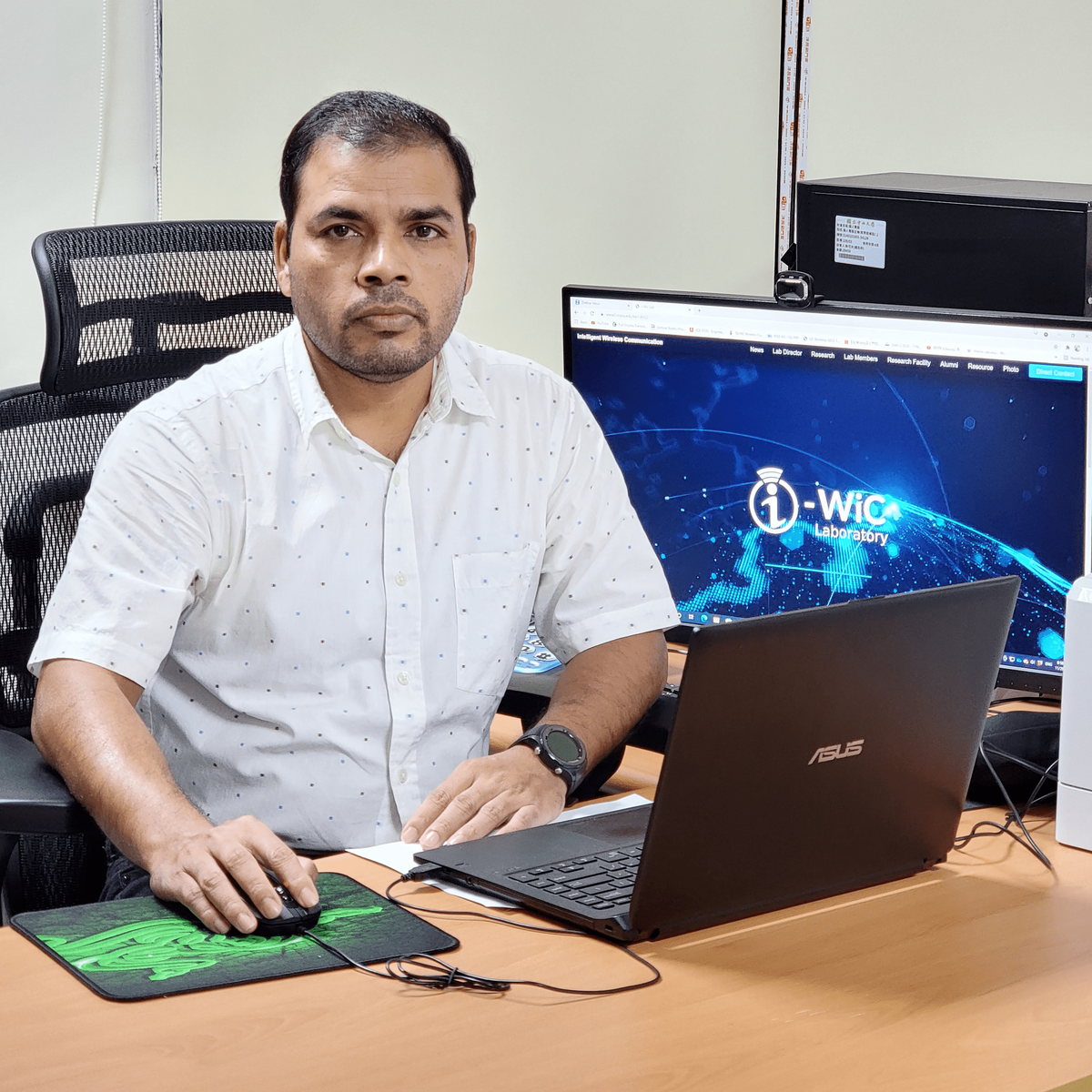World still far from experiencing full potential of 5G technology, says Assistant Professor Keshav Singh


2021-11-30
July 2020, Chunghwa Telecom launched commercial 5G offerings, marking the beginning of the 5G era in Taiwan; other Taiwanese operators quickly followed and made Taiwan become a global leader in 5G download and upload speed in just a year. 5G offers a much faster average download speed than 4G and excellent buffering, however, the world is still far from experiencing the full potential of 5G technology, says Assistant Professor Keshav Singh of NSYSU Institute of Communications Engineering and the International Master’s Program in Telecommunication Engineering who specializes in 5G technologies.
Taiwan owes its success to the combination of software and hardware strengths, as well as international collaborations, he says. The 5G industry is growing fast, however, the world record of 5G download speed of 447.8 Mbps set by Taiwan’s FarEasTone is still far from what 5G can offer, as the technology itself and its deployment still face some difficulties. “Currently, most of the 5G base stations use the already existing 4G infrastructure, and there is limited availability of 5G-compatible user-end devices and limited bandwidth,” said Professor Singh, who is committed to addressing these challenges in his research. “Taiwan, as a leading global hub for semiconductors and electronic products that provides 60% of global supplies of chips, is expected to achieve a full 5G infrastructure in 2 to 3 years, increasing the data transfer speed to gigabits per second and enabling a uniform signal both indoors and outdoors, whether we are moving or not” he says. “A full 5G infrastructure will also allow the implementation of the industry’s best Internet-of-Things (IoT) applications – smart power meter, smart water meter, smart traffic, smart manufacturing, environmental monitoring, wearables, and medical devices.”
The problem of limited bandwidth of the 5G network can be solved with mmWave technology. The era of operating wireless systems at the millimeter wave (mmWave) spectrum, ranging from 30 GHz to 300 GHz, is coming. With several gigahertz potential spectrum, mmWave will be used for access channels in 5G cellular networks. Last year, Professor Singh completed a joint project on dynamic spectrum sharing funded by a US telco Qualcomm Taiwan. “The demand for mmWave technology is growing very fast and the technology is already implemented in private networks and available for commercial use in weather forecasting and flight monitoring in the US, UK, and the European Union.”
So far, 5G is hardly available in rural areas with low population density. This can be changed with Unmanned Aerial Vehicles (UAV). “UAVs don’t need much infrastructure and are suitable for rural areas. Also, in case of disaster, when we cannot reinstate communication immediately, we can fly a few drones in that area to ensure coverage.” Professor Singh is working on the hybridization of reconfigurable intelligent surface (RIS), UAV, and IoT network and on addressing challenges in the deployment of UAVs to improve coverage issues in the suburban areas.
Another problem of 5G is its high energy consumption. “Because 5G is much faster than 4G, 5G devices will contribute to increased CO2 emissions.” Besides the energy-efficient design of 5G devices, there is a need for new technologies, such as RIS – a technology that will reduce power consumption, improve spectral efficiency, mitigate the unwanted interference, extending coverage areas, and enhance the physical layer security. “RIS will be part of the next-generation – beyond 5G and 6G – wireless networks.”
Assistant Professor Keshav Singh is a member of IEEE. He leads research in the areas of green communications, resource allocation, full-duplex radio, ultra-reliable low-latency communication (URLLC), non-orthogonal multiple access (NOMA), wireless edge caching, machine learning for communications, intelligent reconfigurable surface-assisted communications, IoT, and rate splitting multiple access (RSMA). His Intelligent Wireless Communication (i-WiC) Laboratory at the Institute of Communication Engineering at NSYSU collaborates with the world’s leading researchers and aims at responding to the global demand for uninterrupted and ubiquitous communication which can be achieved by beyond 5G and 6G wireless technology, conducting research in next generation multiple access, UAV assisted wireless communications, RIS assisted V2V and V2I communication, artificial intelligence and machine learning for wireless communication. “Our ultimate goal is to sell our ideas to the industry.”
In September 2021, Taiwan’s FarEasTone, which offers 5G download speeds averaging a blistering 447.8 Mbps, became the sole telco in the world to be awarded the title of the Global Winner for 5G Download Speed and 5G Upload Speed in Opensignal 5G Global Awards 2021. In total, 4 Taiwanese telecom companies seized 14 out of 118 recognitions in all 5 categories of the Awards.
Opensignal 5G Global Awards 2021: 5G Global Impact:
https://www.opensignal.com/sites/opensignal-com/files/data/reports/pdf-only/data-2021-09/opensignal5gglobalmobilenetworkexperience2021_0.pdf
July 2020, Chunghwa Telecom launched commercial 5G offerings, marking the beginning of the 5G era in Taiwan; other Taiwanese operators quickly followed and made Taiwan become a global leader in 5G download and upload speed in just a year. 5G offers a much faster average download speed than 4G and excellent buffering, however, the world is still far from experiencing the full potential of 5G technology, says Assistant Professor Keshav Singh of NSYSU Institute of Communications Engineering and the International Master’s Program in Telecommunication Engineering who specializes in 5G technologies.
Taiwan owes its success to the combination of software and hardware strengths, as well as international collaborations, he says. The 5G industry is growing fast, however, the world record of 5G download speed of 447.8 Mbps set by Taiwan’s FarEasTone is still far from what 5G can offer, as the technology itself and its deployment still face some difficulties. “Currently, most of the 5G base stations use the already existing 4G infrastructure, and there is limited availability of 5G-compatible user-end devices and limited bandwidth,” said Professor Singh, who is committed to addressing these challenges in his research. “Taiwan, as a leading global hub for semiconductors and electronic products that provides 60% of global supplies of chips, is expected to achieve a full 5G infrastructure in 2 to 3 years, increasing the data transfer speed to gigabits per second and enabling a uniform signal both indoors and outdoors, whether we are moving or not” he says. “A full 5G infrastructure will also allow the implementation of the industry’s best Internet-of-Things (IoT) applications – smart power meter, smart water meter, smart traffic, smart manufacturing, environmental monitoring, wearables, and medical devices.”
The problem of limited bandwidth of the 5G network can be solved with mmWave technology. The era of operating wireless systems at the millimeter wave (mmWave) spectrum, ranging from 30 GHz to 300 GHz, is coming. With several gigahertz potential spectrum, mmWave will be used for access channels in 5G cellular networks. Last year, Professor Singh completed a joint project on dynamic spectrum sharing funded by a US telco Qualcomm Taiwan. “The demand for mmWave technology is growing very fast and the technology is already implemented in private networks and available for commercial use in weather forecasting and flight monitoring in the US, UK, and the European Union.”
So far, 5G is hardly available in rural areas with low population density. This can be changed with Unmanned Aerial Vehicles (UAV). “UAVs don’t need much infrastructure and are suitable for rural areas. Also, in case of disaster, when we cannot reinstate communication immediately, we can fly a few drones in that area to ensure coverage.” Professor Singh is working on the hybridization of reconfigurable intelligent surface (RIS), UAV, and IoT network and on addressing challenges in the deployment of UAVs to improve coverage issues in the suburban areas.
Another problem of 5G is its high energy consumption. “Because 5G is much faster than 4G, 5G devices will contribute to increased CO2 emissions.” Besides the energy-efficient design of 5G devices, there is a need for new technologies, such as RIS – a technology that will reduce power consumption, improve spectral efficiency, mitigate the unwanted interference, extending coverage areas, and enhance the physical layer security. “RIS will be part of the next-generation – beyond 5G and 6G – wireless networks.”
Assistant Professor Keshav Singh is a member of IEEE. He leads research in the areas of green communications, resource allocation, full-duplex radio, ultra-reliable low-latency communication (URLLC), non-orthogonal multiple access (NOMA), wireless edge caching, machine learning for communications, intelligent reconfigurable surface-assisted communications, IoT, and rate splitting multiple access (RSMA). His Intelligent Wireless Communication (i-WiC) Laboratory at the Institute of Communication Engineering at NSYSU collaborates with the world’s leading researchers and aims at responding to the global demand for uninterrupted and ubiquitous communication which can be achieved by beyond 5G and 6G wireless technology, conducting research in next generation multiple access, UAV assisted wireless communications, RIS assisted V2V and V2I communication, artificial intelligence and machine learning for wireless communication. “Our ultimate goal is to sell our ideas to the industry.”
In September 2021, Taiwan’s FarEasTone, which offers 5G download speeds averaging a blistering 447.8 Mbps, became the sole telco in the world to be awarded the title of the Global Winner for 5G Download Speed and 5G Upload Speed in Opensignal 5G Global Awards 2021. In total, 4 Taiwanese telecom companies seized 14 out of 118 recognitions in all 5 categories of the Awards.
Opensignal 5G Global Awards 2021: 5G Global Impact:
https://www.opensignal.com/sites/opensignal-com/files/data/reports/pdf-only/data-2021-09/opensignal5gglobalmobilenetworkexperience2021_0.pdf
Click Num:
Share
